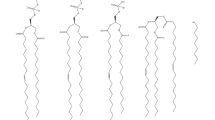Abstract
A physiologic mathematical model was developed to describe the time course of14C-methylene chloride (14CH2Cl2) distribution and elimination in mice following single i.v. administrations of 10 and 50mg/kg. A whole-body model was used to simulate14CH2Cl2 concentrations in blood and tissues, pulmonary clearance of unchanged14CH2Cl2, and metabolic conversion to14CO2 and14CO as monitored by the appearances of these metabolites in expired breath. This diffusion-limited model was identified via a sequential optimization scheme using hybrid models for each compartment. Pulmonary elimination of unchanged14CH2Cl2 was modeled as a linear process while hepatic metabolism of14CH2Cl2 to the compounds14CO2and14CO was described by a saturable metabolic rate term. The model adequately described the dose dependence in methylene chloride distribution and metabolism when simulations were compared to experimental data.
Similar content being viewed by others
References
M. W. Anders, V. L. Kubic, and A. E. Ahmed. Metabolism of halogenated methanes and macromolecular binding.J. Environ. Pathol. Toxicol. 1:117–124 (1977).
A. E. Ahmed, V. L. Kubic, J. L. Stevens, and M. W. Anders. Halogenated methanes: metabolism and toxicity.Fed. Proc. 39:3150–3151 (1980).
J. L. Stevens, J. H. Ratnayake, and M. W. Anders. Metabolism of dihalomethanes to carbon monoxide. IV. Studies in isolated rat hepatocytes.Toxicol. Appl. Pharmacol. 55:484–489 (1980).
R. Toftgard, O. G. Nilsen, and J. A. Gustafsson. Dose-dependent induction of rat liver microsomal cytochrome P-450 and microsomal enzymatic activities after inhalation of toluene and dichloromethane.Acta Pharmacol. Toxicol. 51:108–114 (1982).
V. L. Kubic, M. W. Anders, R. R. Engel, C. H. Barlow, and W. S. Caughey. Metabolism of dihalomethanes to carbon monoxide. I.In vivo studies.Drug Metab. Dispos. 2:53–57 (1974).
G. D. DiVincenzo and M. L. Hamilton. Fate and disposition of [14C] methylene chloride in the rat.Toxicol. Appl. Pharmacol. 32:385–393 (1975).
D. W. Yesair, D. Jaques, P. Schepis, and R. H. Liss. Dose related pharmacokinetics of [14C] methylene chloride in mice.Fed. Proc. 36:998 (1977).
M. J. McKenna and J. A. Zempel. The dose dependent metabolism of [14C] methylene chloride following oral administration to rats.Fd. Cosmet. Toxicol. 19:73–78 (1980).
M. J. McKenna, J. A. Zempel, and W. H. Braun. The pharmacokinetics of inhaled methylene chloride in rats.Toxicol. Appl. Pharmacol. 65:1–10 (1982).
J. R. Withey and B. T. Collins. Chlorinated aliphatic hydrocarbons in the food industry: the comparative pharmacokinetics of methylene chloride, 1,2-dichloroethane, chloroform and trichloroethylene after i.v. administration in the rat.J. Environ. Pathol. Toxicol. 3:323–332 (1980).
J. R. Withey. The comparative pharmacokinetics and uptake of four chlorinated hydrocarbons from vegetable oil and aqueous solution. Proc. Second Int. Cong. Toxicol., Brussels (1980).
M. E. Andersen. Saturable metabolism and its relationship to toxicity.CRC Crit. Rev. Toxicol. 9:105–150 (1981).
R. J. Lutz, R. L. Dedrick, and D. S. Zaharko. Physiological pharmacokinetics: anin vivo approach to membrane transport.Pharmacol. Ther. 11:559–592 (1980).
F. G. King and R. L. Dedrick. Physiologic model for the pharmacokinetics of 2′-deoxycoformycin in normal and leukemic mice.J. Pharmacokin. Biopharm. 9:519–534 (1981).
R. K. Jain, L. E. Gerlowski, J. M. Weissbrod, J. Wang, and R. N. Pierson. Kinetics of uptake, distribution and excretion of zinc in rats.Ann. Biomed. Eng. 9:347–361 (1981).
D. Z. D'Argenio and A. Schumitzky. A program package for simulation and parameter estimation in pharmacokinetic systems.Comput. Programs Biomed. 9:115–134 (1979).
C. W. Gear. The automatic integration of ordinary differential equations.Comm. ACM 14:176–179 (1971).
C. W. Gear. DIFSUB for solution of ordinary differential equations.Comm. ACM 14:185–190 (1971).
F. W. Oehme. Absorption, biotransformation and excretion of environmental chemicals.Clin. Toxicol. 17:147–158 (1980).
K. B. Bischoff, R. L. Dedrick, D. S. Zaharko, and J. A. Longstreth. Methotrexate pharmacokinetics.J. Pharm. Sci. 60:1128–1133 (1971).
A. C. Burton.Physiology and Biophysics of the Circulation. Year Book Medical Publishers, Chicago, (1965), p. 64.
R. L. Dedrick, D. D. Forrester, J. N. Cannon, S. M. El Dareer, and L. B. Mellet. Pharmacokinetics of 1-D-arabinofuranasylcytosine (ARA-C) deamination in several species.Biochem. Pharmacol. 22:2405–2407 (1973).
E. F. Adolph. Quantitative relations in the physiological constitutions of mammals.Science 109:579–585 (1949).
D. B. Tuey and H. B. Matthews. Use of a physiological compartmental model for the rat to describe the pharmacokinetics of several chlorinated biphenyls in the mouse.Drug Metab. Dispos. 8:397–403 (1980).
M. Mintun, K. J. Himmelstein, R. L. Schroder, M. Gibaldi, and D. D. Shen. Tissue distribution kinetics of tetraethylammonium ion in the rat.J. Pharmacokin. Biopharm. 8:373–407 (1980).
F. T. Lindstrom, J. W. Gillette, and S. E. Rodecap. Distribution of HEOD (Dieldrin) in mammals: II. Some applications of the preliminary model.Arch. Environ. Contamin. 3:166–182 (1975).
J. M. Engasser, F. Sarhan, C. Falcoy, M. Minier, P. Letourneur, and G. Siest. Distribution, metabolism and elimination of phenobarbital in rats. Physiologically-based pharmacokinetic model.J. Pharm. Sci. 70:1233–1238 (1981).
R. L. Dedrick, D. D. Forrester, and D. H. W. Ho.In vitro-in vivo correlation of drug metabolism-deamination of 1-Β-D-arabinofuranosylcytosine.Biochem. Pharmacol. 21:1–16 (1972).
Y. Igari, Y. Sugiyama, S. Awazu, and M. Hanano. Comparative physiologically-based pharmacokinetics of hexobarbital, phenobarbital and thiopental in the rat.J. Pharmacokin. Biopharm. 10:53–75 (1982).
P. M. Bungay, R. L. Dedrick, and H. B. Matthews. Pharmacokinetics of halogenated hydrocarbons.Ann. N.Y. Acad. Sci. 320:257–270 (1979).
J. M. Collins, R. L. Dedrick, F. G. King, J. L. Speyer, and C. E. Myers. Nonlinear pharmacokinetic models for 5-fluorouracil in man: intravenous and intraperitoneal routes.Clin. Pharmacol. Ther. 28:235–246 (1980).
J. L. Rheingold, R. E. Lindstrom, and P. K. Wilkinson. A new blood flow pharmacokinetic model for ethanol.J. Pharmacokin. Biopharm. 9:261–278 (1981).
H. Savolainen, K. Kurppa, P. Pfaffli, and H. Kivisto. Dose-related effects of dichloromethane on rat brain in short-term inhalation exposure.Chem.-Biol. Interact. 34:315–322 (1981).
L. Z. Benet. Effect of route of administration and distribution on drug action.J. Pharmacokin. Biopharm. 6:559–585 (1978).
Author information
Authors and Affiliations
Additional information
An erratum to this article is available at http://dx.doi.org/10.1007/BF01073661.
Rights and permissions
About this article
Cite this article
Angelo, M.J., Bischoff, K.B., Pritchard, A.B. et al. A physiological model for the pharmacokinetics of methylene chloride in B6C3F1 mice following i.v. administrations. Journal of Pharmacokinetics and Biopharmaceutics 12, 413–436 (1984). https://doi.org/10.1007/BF01062666
Received:
Revised:
Published:
Issue Date:
DOI: https://doi.org/10.1007/BF01062666




